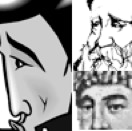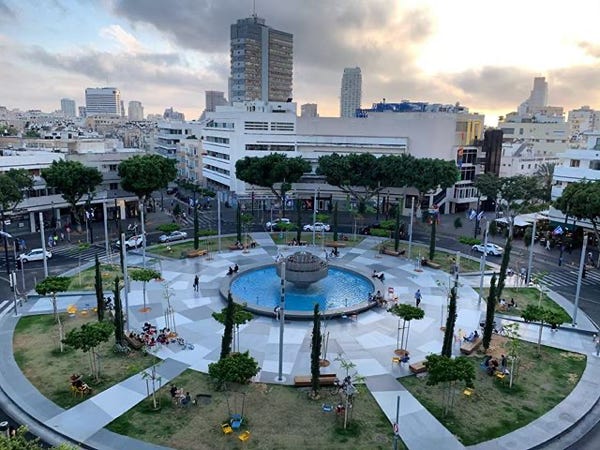
RASHI, RAMBAM and RAMALAMADINGDONG
A Quizbook of Jewish Trivia Facts & Fun

A Quizbook of Jewish Trivia Facts & Fun
Since 2019, Tel Aviv’s Dizengoff Square has been the location of public Kol Nidre and Yom Kippur services, sponsored by Rosh Yehudi, a non profit organization. The services have attracted upwards of 2000 attendees, from Haredi Jews wearing kippot and tallitot, to secular Israelis in shorts and with bared heads, to Orthodox West Bank settlers. Noted author Daniel Gordis referred to the diverse crowd as reflecting the “open embrace of many Jews of different sorts for each other.” But controversy descended upon the planned 2023 Yom Kippur service when what happened?

Dizengoff Square by stupid systemus is licensed under CC BY 2.0
A. There are a number of food trucks that regularly park at Dizengoff Square. In the past they all agreed to close during the service, as the smell of food cooking was disturbing to many attendees. But this year, one felafel food truck owner stated that he would remain open throughout the service, as many attendees and others visiting the square do not fast for the holiday, and in addition, he needed to be preparing food that would be sold immediately after the service when there would be a huge crowd of customers. After much public outcry and further discussion, the truck owner agreed to park a couple of blocks away and move alongside the square only as the service was ending.
B. While head coverings are not required, many attendees wear baseball caps rather than kippot. An organization opposed to the efforts of Prime Minister Benjamin Netanyahu and his government announced that they would be distributing caps at the service which had the word Democracy in Hebrew. Leaders of Rosh Yehudi announced that they would not allow those caps to be worn as they wanted to keep politics out of the service. Ultimately the protestors agreed not to distribute their caps until the end of the service.
C. A centerpiece of Dizengoff Square is a kinetic sculpture by artist Yaacov Agam called the Fire and Water Fountain. At the 2020 Neilah service, a few attendees jumped into the water pool surrounding the sculpture at the point where “who by water and who by fire” was recited during the Unetaneh Tokef prayer. In subsequent years larger numbers of attendees took this action, causing the Tel Aviv Municipality to refuse to issue the permit to Rosh Yehudi this year, for fear of damage to the sculpture. Ultimately, the government relented when Rosh Yehudi offered assurances that they would place barriers and guards to prevent anyone from jumping into the pool, and there were no incidents this year.
D. The Tel Aviv municipality ruled that Rosh Yehudi was not allowed to place a mechitzah, a divider between men and women, in the public square as it violated laws against gender segregation in public places. When Rosh Yehudi’s legal challenge to that decision was denied, they considered canceling the event but ultimately decided to proceed, hanging Israeli flags overhead as a symbolic separation, hoping to mollify both sides of this issue. While the services did take place, there were huge protests from people on both sides of the religious/political spectrum.
E. Word leaked that the organizers of the service had changed the wording of the Unetaneh Tokef, the central prayer chanted during the services. As word spread, many Israelis stated that they would not attend this year’s event. Ultimately, the leaders of the service agreed not to add to the Unetaneh Tokef after “who by water and who by fire,” the phrase “who by Bibi and who by Ben Gvir.”
✡ ✡ ✡ ✡ ✡ ✡ ✡ ✡ ✡
© 2025 MMJZ Services, Inc.